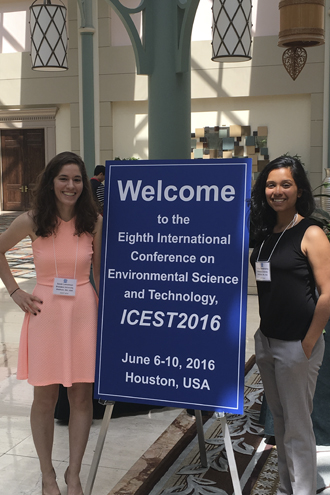Students work with scientists to study air quality in black hair salons
 Photo/Mike Lovett
Photo/Mike LovettSarah Lemelman ’16 and Ramya Ramakrishna ‘16 presented results from the Black Hair Salon Study at the Academy of Sciences’ Eighth International Conference on Environmental Science and Technology in Houston, where they were the only undergraduates to present among hundreds of scientists from around the world.
By the time she was in high school in New York City, Teleah Slater, ’16, knew she wanted to quit the regimen of hair straightening she’d experienced since childhood. She’d long suspected that the chemical burns she’d sometimes get on the back of her neck from the treatment couldn’t be healthy.
“Everyone I knew had straight hair,” Slater said, and convincing her parents that she should cut her chemically-treated hair and let her natural texture grow out wasn’t easy – she couldn’t find any research on the products typically used by African Americans to straighten their hair to show they could be harmful.
Fast-forward to her senior year at Brandeis, and Slater learned about a project being developed by Laura J. Goldin, professor of Environmental Studies, as part of Brandeis’ immersive Environmental Health and Justice Community Field Semester.
Inspired by community partners she has worked with over the years - including Boston’s Resilient Sisterhood Project and Los Angeles-based Black Women for Wellness – Goldin and several environmental health scientists developed a project to study the air quality in hair salons for black women.
While some research has been done on air quality in hair salons generally, little attention has been focused on salons serving primarily black women. Goldin, an attorney with a long-time focus on environmental justice, had previously worked with Brandeis undergraduates on studies of the air quality inside nail salons, and that research inspired other scientists to build on that work.
It was just the kind of project Slater could get excited about.
“I jumped at this chance because it’s something I’m very passionate about, environmental health in general,” Slater said. “It aligned with my academic interests and my personal interests in environmental issues and hair care for black women.”
The 12 undergraduate students who worked on the study went door to door and made cold calls to 90 salons in Boston, eventually recruiting 10 owners who volunteered to participate in what Goldin describes as a pilot study.
The students learned about study recruitment, data gathering and analysis, and they also learned about the cultural significance of women’s hairstyles and salons in the black community through reading and discussion.
“It’s a very complicated space,” Slater said. “It is a safe place that Black women go to be together and leave feeling good about themselves. At the same time, it’s where women may go to conform to a white standard of beauty.”
Air-quality testing results from the salons found fine particulate levels in seven out of the 10 salons to be significantly higher than allowed outdoor levels. Carbon dioxide levels were over recommended limits, indicating insufficient ventilation. Equipment and testing were provided by another key study partner, the Environmental Protection Agency and its laboratory in Chelmsford.
Previous work by students with faculty through the Environmental Health and Justice Community Field Semester on the air quality in nail salons helped bring additional study and attention to conditions in those businesses, where a disproportionate number of workers are Vietnamese. While the Black Hair Salon Study was small, Goldin hopes to see a similar result, where undergraduate research influences other scientists to take a closer look.
“Overall there is a lack of research into environments where workers are primarily women of color,” said Goldin. “We already have joined in collaborative grant proposals with a number of research- and community-based organizations to pursue further research into air quality in black hair salons. Our study provided critical data to support additional investigation.”
In early June, Sarah Lemelman ’16 and Ramya Ramakrishna ‘16 presented the study at the Academy of Sciences’ Eighth International Conference on Environmental Science and Technology in Houston, where they were the only undergraduates to present among hundreds of scientists from around the world. The study is now being prepared for submission to a scientific journal.
Lemelman said attending the conference with so many renowned scientists was inspiring.
“Meeting professors and scientists and attending talks by international experts made me feel very grateful that we were even able to attend the conference, let alone present at it,” Lemelman said. “It gave me experience in preparing a coherent presentation and gave me confidence in presenting to a large crowd of academics and professors, something I'm sure I'll have to do in law school, which is where I will be heading in the fall.”
For Ramakrishna, a data coordinator on the project, the course also had direct implications for her post-Brandeis career. She is now working in recruitment and enrollment for clinical trials at Spaulding Rehabilitation Center in Boston.
“I’m using the same recruitment techniques we learned in the Black Hair Salon Study to work on studies here,” she said. “I want to do environmental health and public health, and so this was an experience I was able to talk about in all my job interviews.”
Categories: General, Research, Science and Technology, Student Life





